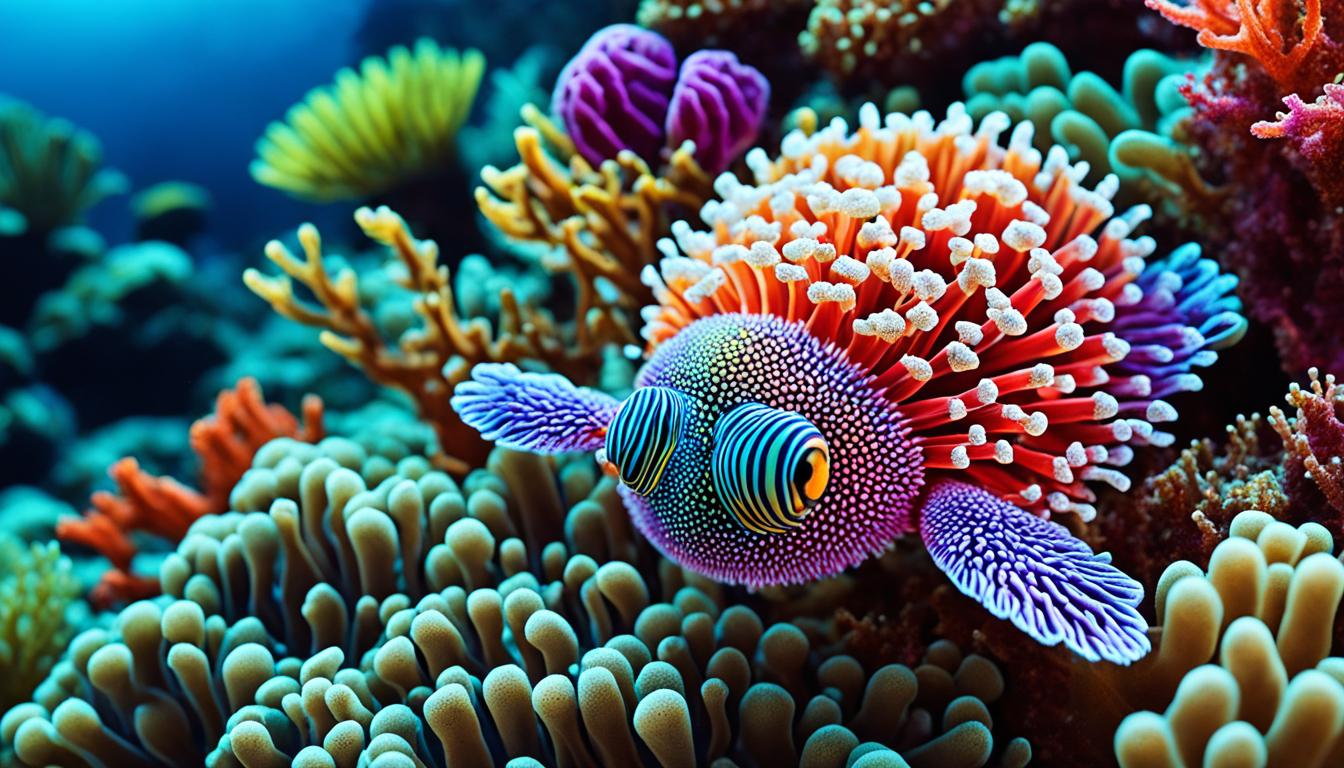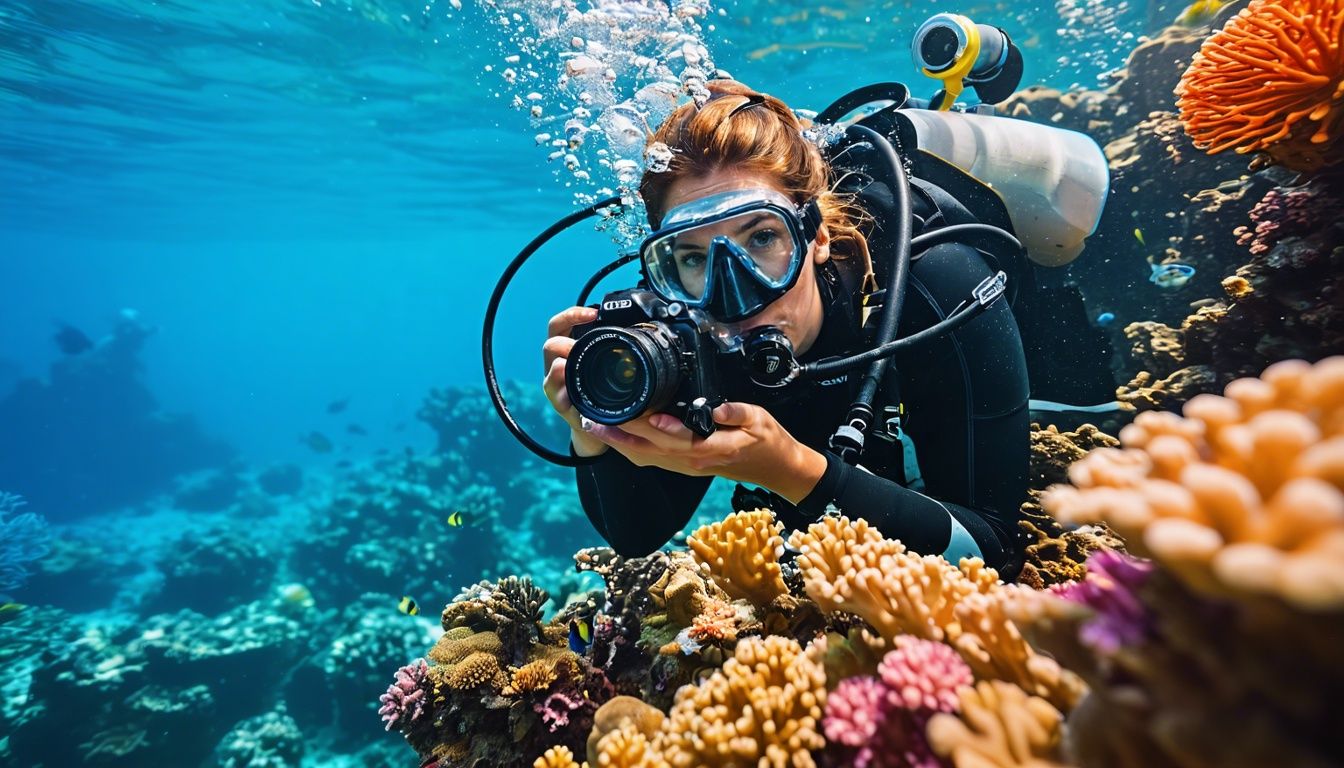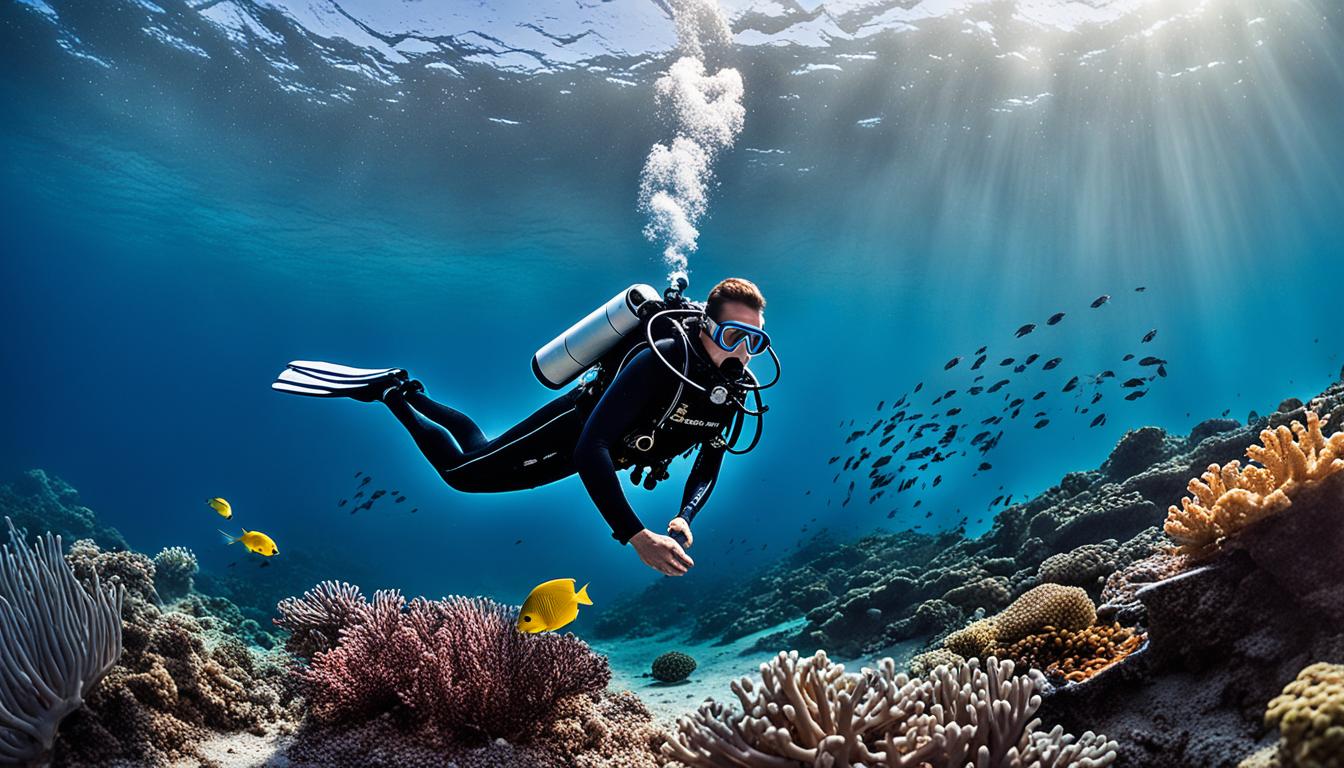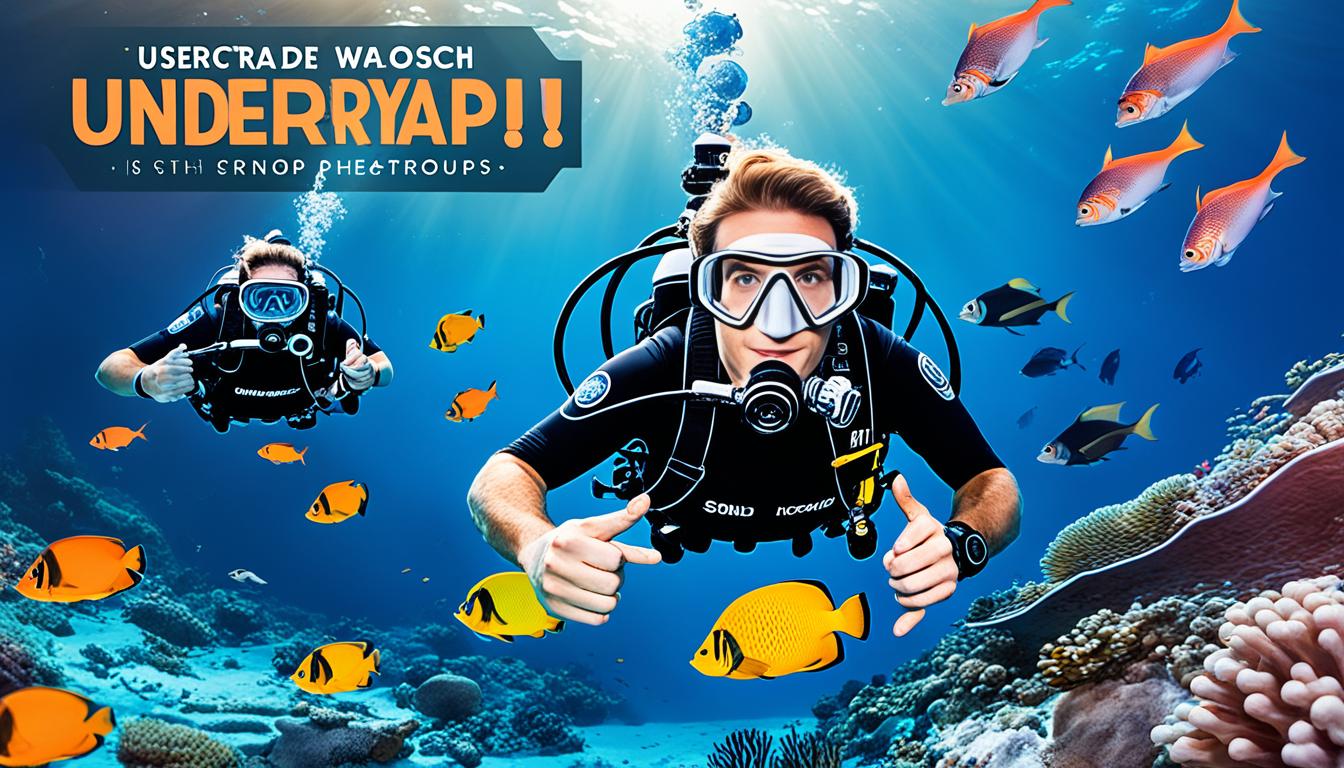Welcome to our guide on mastering the art of macro underwater photography! If you’re passionate about capturing the intricate beauty of small marine life, then this article is for you. Whether you’re a beginner or an experienced underwater photographer, understanding the techniques and tips for capturing stunning macro shots will elevate your photography to the next level.
Macro underwater photography allows us to explore and appreciate the fascinating world of tiny creatures and intricate details that often go unnoticed. From vibrant nudibranchs to delicate seahorses, there is a whole miniature universe waiting to be discovered beneath the surface.
In this comprehensive guide, we will delve into key topics such as aperture and depth of field, underwater macro settings for digital cameras, composition, equipment, and macro lenses. By understanding these essential aspects, you’ll be able to capture captivating images that showcase the vibrant colors, unique behaviors, and hidden wonders of the underwater realm.
Key Takeaways:
- Mastering underwater macro photography allows you to capture the beauty of small marine life.
- Key topics to focus on include aperture, depth of field, composition, and equipment.
- Choosing the right lens and utilizing artificial lighting can greatly enhance macro photography.
- Researching and previsualizing shots will help you locate and capture compelling macro subjects.
- Composition, lighting, focus, exposure, and depth of field are crucial for achieving captivating macro photographs.
Aperture, Depth of Field, and Underwater Macro Settings
In macro underwater photography, understanding aperture and depth of field is essential for achieving stunning images. Aperture refers to the size of the opening in the camera’s lens that allows light to pass through. By selecting the appropriate aperture setting, you can control the amount of light entering the camera and adjust the depth of field.
Depth of field refers to the range of distance within the image that appears in sharp focus. This is particularly important in macro photography, where capturing intricate details and maintaining sharpness is crucial. To achieve a larger depth of field and keep the entire scene in focus, it is recommended to use a small aperture, such as f/22 to f/32.
When it comes to underwater macro settings for digital cameras, specific configurations may vary depending on the camera model. However, there are general guidelines to consider. Synchronizing the shutter speed with the strobes is crucial for capturing sharp images with proper exposure. Using a fast shutter speed helps freeze the motion of small marine life and avoid motion blur.
Internal flashes on cameras are often insufficient for macro shots, especially in the underwater environment. It is highly recommended to use external strobes or video lights to provide adequate artificial lighting. This ensures that the subject is properly illuminated and that colors are accurately captured.
“The positioning of strobes plays a significant role in achieving the desired lighting outcome. Preventing backscatter and achieving even illumination are key considerations. By adjusting the strobes’ position and distance from the lens based on the subject’s proximity, you can achieve optimal lighting results.”
Experimentation and practice are crucial when determining the ideal underwater macro settings for your camera. Understanding how different settings affect the final image allows you to fine-tune your approach and achieve the desired results.
| Aperture Setting | Depth of Field | Recommended Strobe Configuration |
|---|---|---|
| f/22 | Large depth of field, keeping the entire scene in focus | External strobes or video lights positioned to avoid backscatter and achieve even illumination |
| f/32 | Maximum depth of field, ensuring sharpness in the foreground and background | Optimal lighting setup with precise strobe positioning |
By understanding and applying the concepts of aperture, depth of field, and underwater macro settings, you can elevate your macro underwater photography skills and capture breathtaking images of the marvelous marine world.
Underwater Macro Composition and Equipment
When it comes to underwater macro photography, composition is key. By considering factors such as composition, strobe position, background, focus, exposure, and depth of field, we can create visually stunning macro photographs that capture the intricate details of marine life.
Experimenting with different compositions allows us to find unique angles and perspectives that enhance the visual appeal of our macro shots. By adjusting the position of our strobes, we can control the lighting and highlight the subject in the best possible way. Furthermore, paying attention to the background helps us create a pleasing and uncluttered composition.
Of course, achieving optimal image quality requires dedication and fine-tuning. By spending time to perfect our focus, exposure, and depth of field, we can ensure that our images are sharp and well-balanced.
Now let’s talk about the equipment needed for underwater macro photography. Depending on our preference and skill level, we can choose between compact cameras with fixed lenses or DSLRs with interchangeable lenses. Both options have their advantages, so it’s important to choose what suits our needs best.
When it comes to macro lenses, options like the Canon 100mm f/2.8 macro lens and the Nikon 105mm macro lens are highly recommended. These lenses offer excellent results in capturing close-up shots with remarkable detail.
To further enhance our macro capabilities, we can also consider using diopters and extension tubes. These accessories allow for greater magnification and focus on minute details, giving us even more creative freedom with our underwater macro photography.
Tips for Underwater Macro Composition and Equipment:
- Experiment with different compositions to find unique angles and perspectives.
- Adjust the position of strobes to control lighting and highlight the subject.
- Pay attention to the background to create a pleasing and uncluttered composition.
- Dedicate time to fine-tune focus, exposure, and depth of field for optimal image quality.
- Consider using compact cameras or DSLRs with macro lenses for close-up shots.
- Explore the use of diopters and extension tubes for enhanced macro capabilities.
By mastering underwater macro composition and utilizing the right equipment, we can capture the mesmerizing beauty of small marine life in breathtaking detail.

Finding and Capturing Macro Subjects
When it comes to underwater macro photography, finding and capturing the perfect subjects requires a combination of research, observation, and patience. By following a few essential steps, you can enhance your chances of discovering and photographing captivating macro subjects that will truly stand out.
Conducting Thorough Research
One of the first steps in finding macro subjects is to conduct thorough research. Start by exploring online resources and underwater photography forums to gain insights into popular dive locations known for their diverse marine life. Reviewing photos taken by experienced photographers at specific dive sites can provide valuable information about potential macro subjects and their habitats. By doing your research, you’ll be equipped with a list of dive sites that are likely to offer excellent opportunities for underwater macro photography.
Seeking Recommendations and Professional Guides
Experienced divers and underwater photographers can offer valuable recommendations for finding macro subjects. Seek advice from fellow enthusiasts who have explored different dive sites and are familiar with the diverse marine life they offer. Another option is to hire a professional guide who specializes in macro subjects and knows the intricacies of the marine environment. Their expertise can significantly enhance your chances of finding and capturing unique macro subjects.
Approaching with Caution
Once you’ve located a potential macro subject, it’s crucial to approach it with caution and respect for the underwater environment. Maintain an appropriate distance to avoid disturbing the subject or stirring up silt, which can affect water clarity and ruin your shot. By being mindful of your movements and surroundings, you can preserve the natural habitat and capture the subject in its most authentic form.
Patience and Timing
Patience is key in macro underwater photography. Spend time observing your subject, studying its behavior, and waiting for the perfect moment to capture its unique presentation. The underwater world is full of magical moments, and by exercising patience and timing, you increase your chances of capturing stunning macro photographs that tell a story.
Understanding Habitat and Characteristics
To increase your chances of finding suitable macro subjects, it’s essential to understand their habitats and inherent characteristics. Research the particular environment in which your desired subjects thrive, including their preferred depth ranges and behavior patterns. This knowledge will enable you to previsualize your shots and select the most suitable lens and camera settings to capture the finest details.
By following these steps and honing your skills in finding and capturing macro subjects, you’ll be well on your way to creating visually stunning and compelling underwater macro photographs.
Conclusion
Mastering macro underwater photography techniques is the key to capturing the intricate beauty of small marine life. By understanding aperture and depth of field, photographers can manipulate focus and achieve stunning results. Equipping themselves with the right gear, including the best macro lenses for underwater photography, strobes or video lights, and wet diopters, enhances their ability to capture the mesmerizing details beneath the surface.
Composition, lighting, focus, exposure, and depth of field are all critical elements in achieving optimal underwater macro photographs. By meticulously researching potential macro subjects and patiently waiting for the right moment, photographers can express the wonder and uniqueness of the marine world through their images. Understanding the principles of underwater macro composition allows them to create visually compelling and impactful photographs.
Whether you’re an enthusiastic amateur or a seasoned professional, exploring the captivating world of macro underwater photography is a rewarding endeavor. With the right techniques, gear, and composition skills, photographers can embark on a creative journey, unveiling the hidden treasures that reside beneath the waves.
FAQ
What are the key topics to master for macro underwater photography of marine life?
To excel in capturing small marine life through macro underwater photography, it is important to master key topics such as aperture and depth of field, underwater macro settings for digital cameras, underwater macro composition, and equipment for underwater macro photography.
What factors should I consider when it comes to aperture and depth of field in macro underwater photography?
In macro underwater photography, a small aperture, such as f/22 to f/32, is crucial to maintain sharpness and keep the entire scene in focus. This allows for capturing intricate details of small marine life.
What are the recommended underwater macro settings for digital cameras?
Underwater macro settings for digital cameras may vary depending on camera models, but it’s important to synchronize the shutter speed with the strobes and use a fast shutter speed for sharp images. External strobes or video lights are recommended for artificial lighting.
How can I enhance my underwater macro compositions?
Underwater macro composition involves considering factors such as composition, strobe position, background, focus, exposure, and depth of field. Experimenting with different compositions, strobe positions, and backgrounds can enhance the visual appeal of macro photographs.
What equipment is recommended for underwater macro photography?
For underwater macro photography, compact cameras with fixed lenses or DSLRs with interchangeable lenses can be used. Choosing the right macro lens, such as the Canon 100mm f/2.8 macro lens or Nikon 105mm macro lens, is essential for achieving close-up shots of small marine life. Diopters and extension tubes can further enhance macro capabilities.
How can I find and capture macro subjects underwater?
Finding and capturing macro subjects requires research, observation, and patience. Conducting internet searches, seeking recommendations from experienced divers, and reviewing photos taken at specific dive locations can help identify potential subjects. Hiring a guide who specializes in macro subjects can also be beneficial.
How Can Mastering Macro Underwater Photography Help Capture Marine Wildlife Behavior?
Mastering macro underwater photography can greatly enhance marine wildlife behavior photography. With precision and attention to detail, photographers can capture the intricate behaviors of marine life, from feeding to mating rituals. This specialized skill can provide invaluable insight into the secretive world of sea creatures.




